Flow-Based Programming - Chap. VIII
Building Components and Some More Simple Applications
|
This chapter has been excerpted from the book "Flow-Based
Programming: A New Approach to Application Development" (van
Nostrand Reinhold,
1994), by J.Paul Morrison.
To find out more about FBP, click on FBP
. This will also tell you how to order a copy.

For definitions of FBP terms, see Glossary
|
Material from book starts here:
I am now going to describe some simple applications mixing reusable
components
and custom ones. We start with a fairly simple text processing
application
to make a few points about the design of applications in FBP. This is a
classical programming problem, originally described by Peter Naur,
commonly
known as the "Telegram problem". This consists of a simple task, namely
to write a program which accepts lines of text and generates output
lines
of a different length, without splitting any of the words in the text
(we
assume no word is longer than the size of the output lines). This turns
out to be surprisingly hard to do in conventional programming, and
therefore
is often used as an example in courses on conventional programming.
Unless
the student realizes that neither the input nor the output logic should
be
the main line, but the main line has to be a separate piece of code,
whose
main job is to process a word at a time, the student finds him or
herself
getting snarled in a lot of confused logic. In FBP, it is much more
obvious
how to approach the problem, for the following reasons:
-
words are mentioned explicitly in the description of the problem
-
since we have to select our IPs between each pair of processes,
it
is reasonable for the designer to treat words as IPs somewhere in the
implementation
of the problem. It would actually be counter-intuitive to deliberately
avoid
turning words into IPs, given the problem description
-
there is no main line, so the student is not tempted to turn one
of
the other functions into the main line.
Let us dig into the coding of this problem more deeply. We should
have
IPs represent words somewhere in the application. You will have
realized
also that we should have a Read Sequential on the left of the network,
reading
input records from a file, and a Write Sequential writing the new
records
onto an output file. Here is a partial network:

Figure 8.1
Now the output of Read Sequential and the input of Write Sequential
both
consist of streams of IPs containing words and blank space, so it seems
reasonable
that what we need, at minimum, is a component to decompose records into
words
and a matching one to recompose words back into records. Given the
problem
as defined, I do not see a need for any more components, but I want to
stress
at this point that there is no single right answer. Remember ROI? What
you select as your basic black boxes depends on how much they are going
to
be used versus how much it costs to create them.
Let us add our two new components into the picture:

Figure 8.2
Now we have another matched pair of components - in the diagram I
have
labelled them DC (for DeCompose) and RC for ReCompose). Components can
always
find out the actual size of any IP, so we do not have to provide the
size
of the incoming IPs to DC as a parameter. However, RC cannot know what
size
of IPs we want it to create, so this size must be passed as a parameter
to
its OPTIONS port (I didn't have to call it that - but it is good a name
as
any). So let's show an options IIP on RC. RSEQ and WSEQ will also need
to know the identifiers of the files they are working with, so our
diagram
now looks like this:

Figure 8.3
For completeness, I will give some possible pseudo-code for DC and
RC. Remember that, once you have written and tested DC and RC, you have
them
forever. So it is worth the effort to get them "perfect" (as close to
perfect
as software ever gets!). One of the great advantages of FBP is that you
can simply insert a Display process on any connection, e.g. between DC
and
RC, to see if the IPs passing across that connection are correct. So
testing
is very easy.
In what follows, I have assumed (but not shown in the diagram) that
the
input port of both components is called IN and the output port is
called
OUT.
DC (Decompose into Words):
receive from IN using a
do while receive has not reached end of data
do stepping through characters of input IP
if “in word” switch is off and current char non-blank
set “in word” on
save character pointer
endif
if “in word” on and current char blank
set “in word” off
build new string of length =
current pointer - saved pointer)
create IP using new string
send created IP to OUT
endif
enddo
drop a (original input IP)
receive from IN using a
enddo
RC (Recompose Words into Records):
receive output record length from IIP port
drop this IP
create output IP and set it to all blanks
start at beginning of output IP
receive word IP from IN using a
do while receive has not reached end of data
if received word will not fit into output IP
send output IP to OUT
create new output IP and set to all blanks
start at beginning of output IP
endif
move contents of word IP into next space in output IP
if there is room for 1 more character
move in single blank
endif
drop a
receive word IP from IN using a
if receive reached end of data
leave loop
endif
enddo
if output IP has at least one word in it
send output IP to OUT
else
drop it
endif
Maybe this logic can be simplified, but a component does not have to
be
simple on the inside - it should be simple on the outside, and above
all
it must work reliably! This point really illustrates a fundamental
difference
between conventional programming and FBP: I have just shown some
pseudocode,
and you may be feeling that we are back to conventional programming.
However,
another way of putting what I am trying to say is that, because we can
program,
it does not mean that we should. Most conventional programming, and
even
some of the new Object-Oriented approaches, still stress the production
of
new code. Many reuse approaches are based on finding what source code
is
available, and reusing it. Because code is such a malleable medium, and
does not have an inherent component structure, we are always creating
new
stuff and we forget that the results of our work may live long after us
and
that there is a cost to maintaining them, documenting and managing
them. How many times have we heard, "It's less trouble to write my own
than to
find out what's out there"? In FBP, the orientation is the exact
reverse:
use what's out there, and only build new if you can justify the effort
in
terms of ROI. This is where experience becomes valuable: after you have
done the same job many times, you know whether other people will find
components
like DC and RC useful. If you know they won't, find another way to do
the
job!
Now we have a matched pair of useful components, but, of course, you
don't
have to use them together all the time. Let's suppose we simply want to
count the number of words in a piece of text. We have already mentioned
the Count component in the Concepts chapter - it simply counts all its
incoming
IPs and generates a count IP at the end. It has an option which is
substream-sensitive
(it generates one count IP for each incoming substream), but for now we
will
use it in its most basic form. In this form, it simply sends the count
it
has just calculated out via one output port, while the original
incoming
IPs are sent out of another one if it is connected (this is an example
of
an optional port). This type of component is sometimes called a
"reference"
component, meaning that the original input IPs are passed through
unchanged,
while some derived information is sent out of another output port. So
the
resulting structure will look something like this (we won't bother to
connect
up Count's optional output):

Figure 8.4
We can keep on adding or changing processes indefinitely! These
changes
may result from changing requirements, new requirements or simply the
realization
that you can use a component that was developed for one application on
another. We talked in the chapter on Reuse about some of the principles
behind designing
components for reuse.
As another more elaborate example, instead of counting the words, we
could
decide to sort them, alphabetically or by length. Once we have the
words
sorted alphabetically, it might be nice to be able to insert fancy
heading
letters between groups of words starting with the same letters, like
some
dictionaries.... Of course, once we have sorted them, we should
eliminate
duplicates. The resulting diagram would then look like this
(partially):
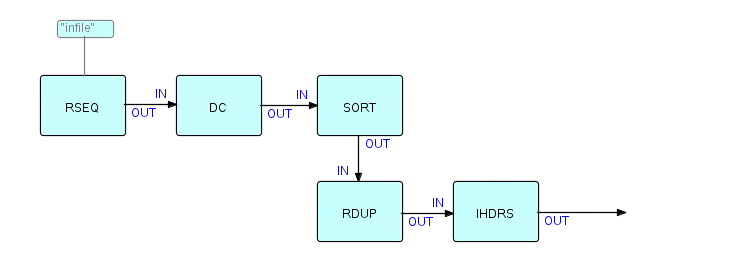
Figure 8.5
where RDUP means "Remove Duplicates" and IHDRS means "Insert Header
Letters".
It will come as no surprise that text processing applications have
been
very productive of generalized components. This is also the application
area where the UNIX® system has proven very productive. The UNIX
pipe
mechanism is very similar to FBP's data streams, except that UNIX
communication
is based on using streams of characters, whereas FBP's communication is
by
means of structured IPs.
An excellent example of this kind of text-processing application is
P.R.
Ewing's publication a few years ago of a Concordance to the Ukrainian
Bible
(1988) - this was programmed using DFDM, and Philip found DFDM to be
very
well suited to this type of work. He has recently completed a Biblical
Concordance
for Xhosa (one of the languages of South Africa), using the PC-based
THREADS
software. He reports that, after spending between 100 and 150 hours
trying
to develop this Concordance using conventional (non-FBP) software, he
eventually
had to abandon it unfinished. With THREADS he was able to produce a
completed
Concordance with about 40 hours of work (of course this does not
include
the time needed to input the Bible text). He told me that, as far as he
was concerned, the big advantage of FBP is the fact that it simplifies
the
complexity of an application, and 40 hours vs. more than 100 hours
certainly
seems to bear this out.
We have used the Sort function as a component a number of times in
the
foregoing examples. In conventional programming, Sort is usually
packaged
as a stand-alone utility, although various exits are provided to allow
its
behaviour to be modified. What are the advantages of packaging it as an
FBP component? People very often have the reaction that Sort cannot be
a
good FBP component because it is too "synchronous" - all the input has
to
be read in before any of it can be sorted; then the sort proper takes
place;
then all the sorted records are output by a final merge phase. However,
we have found a stream-to-stream sort to be a very effective FBP
component
for the following reasons:
-
Performance: a Sort which is run as a separate job step has to
use files
for its input and output, and the control fields have to be in the same
place
in every input record. If we provide Sort as a stream-to-stream
component,
then data IPs which are to be sorted no longer have to be written to a
file
first (and do not have to be retrieved from a file afterwards), but can
simply
be sent across a connection to the Sort, which in turn sends them on to
the
next process when it is finished, resulting in a considerable savings
in
I/O overhead. Actually, the "central" sort phase is the only part of
the
sort which cannot be overlapped with other processes.
-
Flexibility of positioning control fields: if the control fields
are
not in a standard place for all the input IPs, you can simply insert a
transform
process upstream of the Sort to make the key fields line up.
-
Eliminating unnecessary sorting: sometimes, some of the IPs are
known
to be already sorted, in which case they can bypass the Sort, and be
recombined
with the sorted IPs later. This is often not practical when the Sort is
a separate job step.
-
Improved sorting techniques: if you know something about the
characteristics
of your keys, you may be able to build more complex networks which
perform
better than a straight sort. For instance, if you are sorting on a name
field, it might make sense to split the data 26 ways, sort each stream
independently,
then merge them back together - I don't say it will definitely, but you
can
try it out. The sort process can thus be implemented with other
components
or subnets for purposes of experimentation.
Although some sorts are faster, a good rule of thumb is that the
running
time of most sorts is proportional to n.logn, where 'n' is the number
of
records. Since this is a non-linear relationship, it may be more
efficient
to split your sort into several separate ones.
Here is a picture of a Sort with some IPs going around it, and with
sort
tags being generated on the fly by an upstream process (GTAG):

Figure 8.6
Actually Sort is an example of something I discovered quite early in
the
work on FBP: FBP enables you to tie together things which didn't expect
to
be tied together! If you can persuade something to accept and generate
data
packets, it can talk to other things which talk in terms of data. For
instance,
once you have converted Sort to a stream-to-stream component, it can
talk
to other utilities, HLLs, DB2, etc. They don't necessarily have to be
callable
- they just have to be able to accept and generate data once they are
given
control. I have written networks which contained Assembler, COBOL and
PL/I
programs, all in the same network. I also built an application which
used
a screen manager written in Assembler, REXX for all of its calculation
logic,
used reusable components for screen management and GDDM/PGF for drawing
charts
when requested by the user. Another network spanned two CMS virtual
machines,
communicating by means of VMCF. This is a point we'll come back to
later: you can design a big network, and then split it across different
machines,
processors, software systems, etc.
Incidentally, there is a flip side to this ability to tie things
together
'without their knowledge': we alluded above to the fact that components
have
to be reentrant if they are going to multithread with each other.
Strange
things happen if you try to multithread processes which are not
reentrant!
After we had turned Sort into a stream-to-stream process, it seemed
reasonable
to want to run more than one Sort process in a single network. As long
as
one had fully completed before the other one started, we had no
problems. When we tried to overlap two Sorts in time, strange things
happened. We
suspected that reentrancy was being violated, but it did not
consistently
cause problems. Some people reported that everything ran fine, others
that
it always crashed! After we ruled out the possibility that it was
programmer-induced,
we eventually figured out that some of the sort techniques used by Sort
were
reentrant (probably the more recent ones), and some not, so some file
formats
or volumes caused problems (because they triggered different sort
techniques),
while others did not. We decided that the safest thing to do was
interlock
the Sorts so that one couldn't start until the other had finished (this
is
not a great solution as it requires deciding which Sort should run
first,
which you will probably have realized by now runs counter to the
philosophy
of FBP).
<>This anecdote reminds me of a pitfall when using Writers to
write to
PDS's ["Partitioned Data Sets"] under IBM's MVS (even if you are
not an MVS user, other operating
systems
support similar structures, so it may still be instructive). PDS's are
data
sets which contain a series of subfiles (members), with a directory at
the
front. A number of programmers used multiple instances of the Writer
component
in DFDM to try to write more than one member at the same time. What
these
programmers saw was that the resulting members seemed to have a mixture
of
each other's data! In MVS, we are so accustomed to treating PDS members
as if they were ordinary files that it is not immediately obvious why
writing
two or more at the same time should cause problems. Of course, the
moment
it is pointed out, it becomes obvious: PDS's only "grow" at the end. If
a PDS already has a member "A", and you decide to write to member "A",
what
actually happens is that you write the new data at the end of the PDS,
and
afterwards, when the new member is complete, the directory is updated
to
point at the new member (leaving what is often referred to as "gas" in
the
middle [this happens if you are updating a PDS member, or a member has
been deleted]). If you try writing to two members concurrently, the two
writer
processes will see the same "end of PDS", and will both start writing
at
the same spot. The two processes then write blocks alternately, after
which
both directory entries are updated to point to the old end of the PDS!
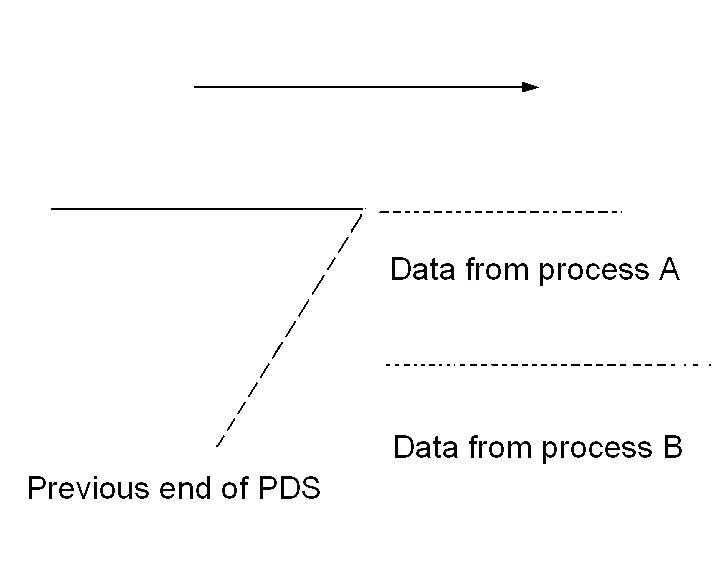
Figure 8.7
Now let's go back to the original Telegram problem, but first we are
going
to program it using conventional (control-flow) programming. Hopefully
the
reason for doing this will become clear soon.
From the above discussion, we see that words are the key concept
needed
to make this problem tractable. Once we realize this, we can go ahead
and
code it up, using something like the following call hierarchy:
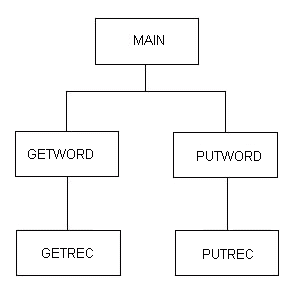
Figure 8.8
As we have said above, it is not at all obvious at first in
conventional
programming that this is the right way to tackle this job. Most people
who
tackle this problem start off by making GETWORD or PUTWORD the "boss"
program,
and promptly get into trouble. So we now realize that we have to "bring
in a boss from outside" (call it MAIN), instead of "promoting" GETWORD
or
PUTWORD to boss. Now MAIN can call GETWORD and PUTWORD to retrieve and
store
a single word at a time, respectively. To do this GETWORD must in turn
call
GETREC and PUTWORD must call PUTREC, to look after the I/O. Now note
that
all four of these subroutines have to "keep their place" in streams of
data
(streams of words or streams of records). In the old days we did this
by
writing them all as non-reentrant code, so the place-holder information
essentially
became global information. This is quite correctly frowned on as poor
programming
practice, as it has a number of significant disadvantages, so today we
normally
manage this kind of place-holding logic using the concept of "handles".
The general idea (for those of you who haven't had to struggle with
this
kind of logic) is for MAIN to pass a null handle (in many systems this
will
be a pointer which is initially set to zero) to GETWORD. When GETWORD
sees
the null handle, it allocates a block of storage and puts its address
into
the handle. Thereafter it uses this block of storage indirectly via the
handle, and at the end of the run, frees it up again. Although this
block
of storage is allocated and freed by GETWORD, it is considered to be
owned
by MAIN. This same logic is also used between MAIN and PUTWORD, between
GETWORD and GETREC, and between PUTWORD and PUTREC. At the basic level,
our problem is that subroutines cannot maintain internal information
which
lasts longer than one invocation. In contrast, FBP components are
long-running
objects which maintain their own internal information. They do not have
to be continually reinvoked - you just start them up and they run until
their
input streams are exhausted. Thus, FBP components can do the same
things
subroutines do, but in a way that is more robust and, something of
considerable
interest for our future needs, that is also more distributable. It is
important
to note that FBP does not prevent us from using subroutines, but my
experience
is that they are most appropriate for such tasks as mathematical
calculations
on a few variables, doing look-ups in tables, accessing data bases, and
so
on - in other words tasks which match as closely as possible the
mathematical
idea of a function. Such subroutines are said to be "side-effect free",
and experience has shown that side-effects are one of the most common
causes
of programming bugs. Hence subroutines which rely on side-effects for
their
proper functioning are a pretty poor basis on which to build
sophisticated
software!
At this point, to get you back in the data flow mood, let's talk
about
the text-processing example I talked about above. You remember the
above
example, where we want to take some text, split it into individual
words,
sort them, remove duplicates, insert fancy letters on every letter
change,
and print out the result. Oh, and let's print it out in two columns.
Using
FBP, this is quite simple - actually, we have just described the FBP
network
structure! I will leave this as an exercise for the reader. It also
illustrates
a point [the late systems architect] Wayne Stevens has made frequently
-
namely, that we very often want to string a whole bunch of functions
together
in a serial manner. We say "do A and B and C and...", which is
basically
the same as "take the output of A and feed it to B; now take the output
of
B and feed it to C, and so on..." This is exactly the same as the
pipelines
of the UNIX system or MS DOS. This is a very natural and important
function,
and it is essential to be able to express this kind of linkage with a
minimum
number of key-strokes. In the DFDM and THREADS interpretable notation
we
use two key-strokes (->) to represent this relationship.
So far, we have worked with quite simple structures which either
string
together "filters" in what is sometimes called a "string of pearls"
pattern,
or we had one data stream generate more than one ("divergent"
patterns). There is a point to be made about divergent flows: once two
streams diverge,
they will no longer be synchronized. Some software systems go to a lot
of
trouble to keep them synchronized, but our experience is that, most of
the
time, it is not necessary or desirable. There are ways to resynchronize
them if you really have to, but you may find it's not worth the
trouble! For one thing, in the chapter on deadlocks we will find that
resynchronization
is a potential cause of deadlocks.
People very often split data streams so that different parts of
their
networks can handle different IP types - this works best if you do not
need
to retain any timing relationships between the different types. If you
do,
there is a variant of the "string of pearls" technique that you may
find
useful: have each "pearl" look after one IP type and pass all the other
ones
through. Its (partial) pseudo-code would then look as follows:
receive from port IN using a
if type is XXX
process type XXX
endif
send a to port OUT
You can then string as many of these together as you want and each
pearl
will look after its own data type and ignore all the others.
Now it's time to talk about various types of Merge function. There
is
a basic merge built right into FBP - the first-come, first-served
merge. This is done very simply by connecting two or more output ports
to one input
port, as follows:
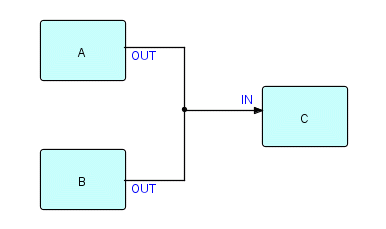
Figure 8.9
where ports OUT of A and OUT of B feed into port IN of C. IPs being
sent
out along this connection to the IN port of C will arrive interleaved.
The
IPs sent out by a single process will still arrive in the correct
sequence,
but their sequencing relative to the output of the other process will
be
unpredictable. Why would you use this structure? Surprisingly often! C
might be a Sort, so the sequence of its incoming IPs is going to be
changed
anyway. The IPs from the two output streams may be easily
distinguishable,
so we can always separate them out later. C may be interested in
receiving
its input data as fast as possible - any additional sequencing may
cause
delays, and in fact may even cause deadlocks.
Now perhaps the first-come, first-served merge may not be adequate,
in
which case we will need a process at the junction of the two streams.
This
may be a custom-coded merge component, or you may be able to use one of
the
ones supplied with the FBP software, for instance Collate or
Concatenate. Both of these use one or more port elements of a single
array port to handle
their input streams, so we will use this convention. The reason for
this
is that they can handle any number of input streams up to the
implementation
maximum. Of course, custom components could call one input port JOE and
the other one JIM - it's up to the developer (of course assuming the
component's
users will put up with it!).
Our diagram now looks like this:
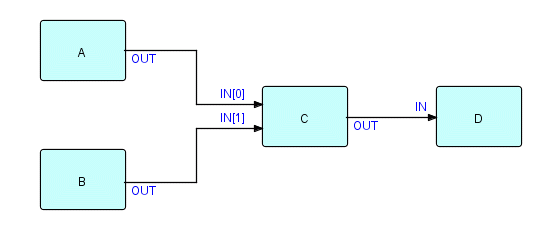
Figure 8.10
Now we have:
-
OUT of A connected to IN[0] of C
-
OUT of B connected to IN[1] of C
-
OUT of C connected to IN D
If C is a Collate, then the output of A will be merged with the
output
of B according to key values - usually the key fields are specified to
Collate
by means of option IPs. Alternatively the Collate may use one or more
named
fields which will be related to the IPs by means of descriptors (see
that
chapter). One might also visualize Collates which are
substream-sensitive
- we might want to merge substreams based on a particular field in the
first
IP of each substream.
Now, if we were to use Concatenate instead of Collate, then what we
are
saying is that we want C to send all of A's output on to D before it
accepts
any of B's output. As we said above, there are some situations where
this
can be useful, too. Collate, however, is a very powerful component, and
in conjunction with the ideas described in the next chapter,
significantly
simplifies application programs which would be extremely complex using
conventional
programming techniques.
![]()









